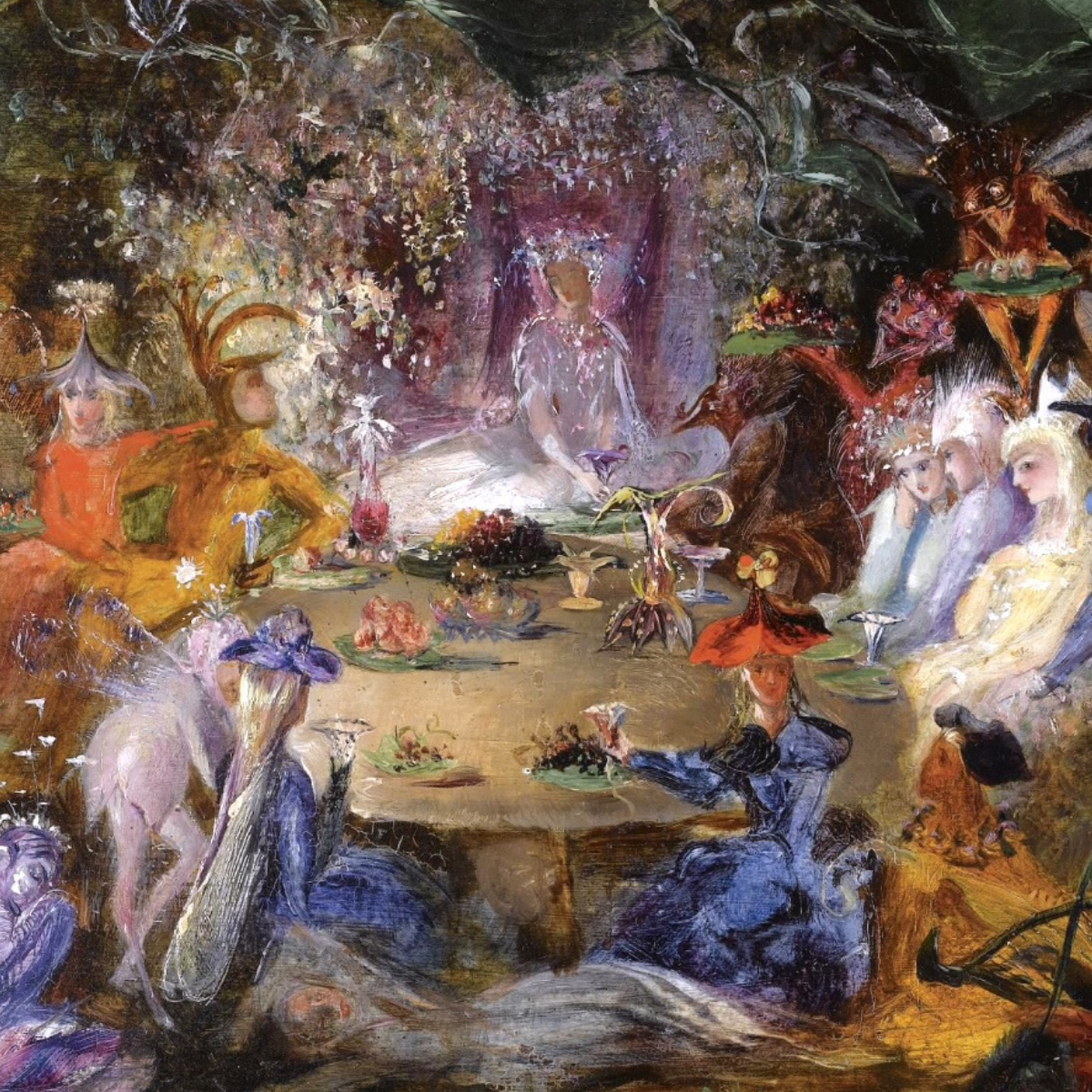Here in the US, we’re approaching the Thanksgiving holiday, where folks often share a traditional meal with family and/or friends. This is why I have food on the brain for this month’s blog post. 🙂 And it put me to wondering, from a folklore standpoint would it have been a good idea to share a meal with the faeries?
Within faerie folklore, food often plays a pivotal role. Routinely, faeries were dependent on humans as the primary source of their food. Lurking in homes and fields, faeries would take food from mortals as they wished.
Yet many folktales describe how scrumptious and captivating faerie food was. Was it wise to eat faerie food, though? And why would faeries have been interested in our food? Let’s find out!

Faeries Loved to Beg, Borrow, and Steal Food
While faeries were known for stealing shiny things, borrowing implements, and more seriously, kidnapping people, they were also believed to be quite adept at food theft. Many folktales relate how faeries borrowed or stole dairy products, like milk and butter, as well as grains and bread.
In The Encyclopedia of Celtic Mythology and Folklore, Patricia Monaghan describes faerie desire (and morality) when it came to pilfering human food:
For all their sensitivity to humans stealing from them—a misdemeanor that they punished with all their might—the fairies thought nothing of stealing from humans. Food was their favorite target, for their own fairy food was not as nourishing as ours.
I found that the concept of nourishment came up quite a lot while I researched this topic. As noted above, faerie food was considered less nourishing, which is why faeries might have found value in stealing human food. But there are also descriptions of how faeries simply spirited away the nutritional, nourishing essence from human food. According to Monaghan, the food that remained would have been “stale and dry and useless.”
Katharine Briggs in her reference work, An Encyclopedia of Fairies: Hobgoblins, Brownies, Bogies, and Other Supernatural Creatures, elaborates on the idea of faeries stealing away the nutritional aspect of food. Referring to Robert Kirk (a Gaelic scholar and folklorist) and J. G. Campbell (a collector of Highland tales), she writes:
The fairies also steal the essential good out of human food, and leave an unnourishing substance behind them. Kirk speaks of their stealing away the ‘foyson’ of human food, and Campbell uses the Gaelic ‘toradh’.
Briggs uses the term “goodness” as a synonym to “foyson” and “toradh.” By stealing this “goodness” from human food, the faeries would have been taking the most valuable aspect of the food. As a result, people often used charms and protections to keep their food safe from faerie theft. (More to come on that later!)
Faerie Food: A Description of Delicacies and the Side Effects of Consumption
To better understand why faerie food may not have been as nourishing as ours, I turned back to Briggs’ book. She explains that while faerie food “appears by glamour to be rich and elegant, [it] consists of weeds.” Additionally, she includes a very precise description of it provided by J. G. Campbell. She writes:
According to Campbell … [faerie food] consists of brisgein (that is, the roots of silverweed), stalks of heather, milk of red deer and goats, and barley meal.

But with a heavy helping of glamour (and perhaps some spices), the faeries could transform their twig and leaf offerings into a sumptuous banquet, which they would use to tempt humans who were visiting Faerie. Monaghan explores this topic in her book as well. She relates how many tales depict faerie food as extremely delicious, but she offers up a warning:
It was especially important never to eat when visiting Fairyland, whether by choice or because one was the victim of fairy kidnapping, for once a human devoured fairy food there, it was virtually impossible to return to earthly life.
It seems that in the stories I came across while researching this post, the person who ate faerie food while in Faerie would either remain trapped there indefinitely, or if they were able to escape, would pine for the treats of Faerie and sometimes died from their burning desire for it.
Be Sure to Guard Your Grains and Bread
Even though faerie food was touted to be the tastiest of all food, the faeries still preferred human food. Briggs relates that some faeries would sneak into fields or barns to carry off grain from under the farmer’s nose.
Bread was also a favorite food of the faeries. Monaghan explains that if a fresh loaf of bread was left unattended, it might get swiped by hungry faeries.
But in Welsh faerie folklore, there exists a common type of tale where humans intentionally aided faeries in baking bread. In Celtic Folklore: Welsh and Manx, John Rhŷs describes how the Lleyn Peninsula in North Wales is rich in stories of faeries borrowing human baking implements in order to bake bread and cakes. He explains that the tools they borrowed were a gradell (a griddle or bakestone “on which the dough is put”) and a padell (the “pan put over it”). Rhŷs relates a story told to him by a man named Lewis Jones:
… when they [human women] had been baking, they took care to leave the fairies both padell and gradell, that they might do their baking in the night. The latter used to pay for this kindness by leaving behind them a cake of fairy bread and sometimes money on the hob. I have, however, not been able to learn anything about the quality or taste of this fairy food.
I came across a similar tale in Welsh Folk-Lore: A Collection of the Folk-Tales and Legends of North Wales by Elias Owen. In this version, a woman named Mary Roberts would receive a loaf of bread from the faerie who borrowed her gradell once a week. But this faerie had one demand: Mary was not to watch her leave when she left Mary’s house. One day, though, Mary “transgressed, and took a peep as the Fairy went away.” Not pleased, the faerie went to a nearby lake, “plunged into its waters, and disappeared.”
Use Charms to Protect Milk and Butter
Dairy products also seemed to hold great appeal for faeries—especially butter, milk, and cheese. Rhŷs notes that within Wales, many faeries were “of a thieving disposition” when it came to dairy goods. In general terms, he writes of faeries who seize butter and cheese from dairies and take it upon themselves to milk cows and goats as they please.
Butter was seen as a great favorite of the faeries. Monaghan writes that if a woman worked hard at churning, but the butter did not seem to be forming, then often the faeries were blamed for stealing it away. And while faeries might milk cows directly, they also stole it from milk pails or by making a person drinking milk spill some.

Monaghan further explains how charms (“a spell or incantation to attract good fortune”) were often used as a counter measure to faerie thefts:
The Celtic lands provide many examples of charms, which entailed certain ritual gestures, specified offerings, the gathering of specific herbs, and/or incantatory words. Charms were sung to hasten the butter, when the monotonous action of churning milk began to tire the milkmaid. … A milking charm collected in Scotland is typical: With each flow of milk a new verse was sung, calling on a different saint, for many ancient charms were Christianized and continued in use even until recent years.
In addition to singing charms to protect the butter, Monaghan notes that folks also placed holy water or leaves from a mullein plant inside of the churn. And placing iron nails in your milk pail was another option, as it was believed that faeries had a great fear of iron.
Yet the Faeries Could be Generous
Apparently faeries did have a generous side with respect to food. Briggs describes how borrowing food and utensils went both ways in faerie and human dealings. If the faeries lent food to mortals, they usually only expected an equivalent return in response to their generosity. But when faeries borrowed from humans, they included a sort of interest and gave back more than they had borrowed. Although, they were wont to give back barley if they had borrowed oats.
In addition, while eating faerie food within Faerie was dangerous, consuming it in the human realm could bring good luck. Briggs points to a common type of tale in which a human (often a ploughman or farm laborer) fixes a broken tool that belongs to the faeries. In return, the faeries leave a delightful cake for the person who helped them. In these stories, eating the cake brings good fortune to the human.
Finally, Monaghan describes how some faerie stories from Ireland that tell of the Great Famine (1840s) include aspects of faerie generosity. In these tales, the faeries give away their own food, for example by leaving treats in an abandoned field, which keeps the humans in the story from going hungry. This made me wonder if faerie food lore perhaps primarily stemmed from food difficulties. Much of the folklore I encountered while researching seemed to be cautionary in some way.
I was glad, though, to find some hopeful tales involving food with both generous humans and faeries alike. Perhaps sharing a meal with the faeries wouldn’t end badly—so long as the meal was eaten on this side of the veil.
I’d Love to Learn About Your Favorite Winter Traditions
Do you have a favorite (or unique, fun, interesting) winter tradition that you’d like to share with our community? I thought it would be fun to collect and share your winter traditions in the December newsletter and blog post!
You could describe a personal, family, or cultural winter tradition. Or you could reflect on a December holiday or end-of-year tradition. It can be a tradition that you participate in or one from the past that you find fascinating.
To make it easy to respond, I’ve created a short Google form. The form will be available until December 7, 2025. If you’d like to participate, click on the link below to access the form:
As ever, thank you for reading my blog. If you know someone fascinated by folklore, feel free to share this post with them.
Art credit (featured image): The Fairies’ Banquet by John Anster Fitzgerald (cropped) via Wikimedia Commons, public domain




